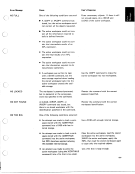:pagsword is the security password assigned by a previous )WSID or )SAVE
command. If no password was assigned previously, a password cannot be
specified by this command.
object name(s) (optional) is the name of the global object(s) to be copied from
the designated stored workspace. If this parameter is omitted, all global ob-
jects in the designated stored workspace are copied.
The )DROP Command
The )C)ROP command marks a specified file unused. After the file has been
marked unused, the data in the file can no longer be read from the tape. When
the command is successfully completed, DROPPED device/file number file ID is
displayed.
Syntax
)DeOP device/file number [fKD]
where:
dev,ice/file number is the number of the tape unit and the file on the tape.
file, ID (optional) is the name of the stored workspace file to be marked unused.
If the file number specified is a data file, any file ID specified is ignored.
The )ERASE Command
The )@RASE command erases the named global objects from the active work-
space.' There is no message displayed at the successful completion of the com-
mand.
Motes:,
1. When a pendent function (see Chapter 7) is erased, the response SI DAMAGE
2. If dhe object being erased is a shared variable (see Chapter 8), the shared vari-
3. Even after the object is erased, the name remains in the symbol table (the
is iSsued.
able will be retracted.
part of the active workspace that contains all the symbols used).
Syntax 1
)ERASE obiect name(s1
where:
obilect name(s1 are global names separated by blanks.
16
command. If no password was assigned previously, a password cannot be
specified by this command.
object name(s) (optional) is the name of the global object(s) to be copied from
the designated stored workspace. If this parameter is omitted, all global ob-
jects in the designated stored workspace are copied.
The )DROP Command
The )C)ROP command marks a specified file unused. After the file has been
marked unused, the data in the file can no longer be read from the tape. When
the command is successfully completed, DROPPED device/file number file ID is
displayed.
Syntax
)DeOP device/file number [fKD]
where:
dev,ice/file number is the number of the tape unit and the file on the tape.
file, ID (optional) is the name of the stored workspace file to be marked unused.
If the file number specified is a data file, any file ID specified is ignored.
The )ERASE Command
The )@RASE command erases the named global objects from the active work-
space.' There is no message displayed at the successful completion of the com-
mand.
Motes:,
1. When a pendent function (see Chapter 7) is erased, the response SI DAMAGE
2. If dhe object being erased is a shared variable (see Chapter 8), the shared vari-
3. Even after the object is erased, the name remains in the symbol table (the
is iSsued.
able will be retracted.
part of the active workspace that contains all the symbols used).
Syntax 1
)ERASE obiect name(s1
where:
obilect name(s1 are global names separated by blanks.
16









































































































































































































































